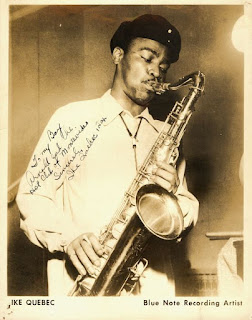Ike Abrams Quebec (August 17, 1918 – January 16, 1963) was an American jazz tenor saxophonist. He began his career in the big band era of the 1940s and then fell from prominence for a time until launching a comeback in the years before his death.
 Critic Alex Henderson wrote, "Influenced by Coleman Hawkins and Ben Webster but definitely his own person, Ike Quebec was one of the finest swing-oriented tenor saxman of the 1940s and ’50s. Though he was never an innovator, Quebec had a big, breathy sound that was distinctive and easily recognizable, and he was quite consistent when it came to came to down-home blues, sexy ballads, and up-tempo aggression.”
Critic Alex Henderson wrote, "Influenced by Coleman Hawkins and Ben Webster but definitely his own person, Ike Quebec was one of the finest swing-oriented tenor saxman of the 1940s and ’50s. Though he was never an innovator, Quebec had a big, breathy sound that was distinctive and easily recognizable, and he was quite consistent when it came to came to down-home blues, sexy ballads, and up-tempo aggression.”Quebec was born in Newark, New Jersey, United States. An accomplished dancer and pianist, he switched to tenor sax as his primary instrument in his early twenties, and quickly earned
a reputation as a promising player. His recording career started in 1940, with the Barons of Rhythm.
Later on, as a sideman he recorded or performed with Frankie Newton, Hot Lips Page, Roy Eldridge, Trummy Young, Ella Fitzgerald, Benny Carter and Coleman Hawkins Between 1944 and 1951, he worked intermittently with Cab Calloway. He began to record for the Blue Note label in this era, and served as a talent scout (helping pianists Thelonious Monk and Bud Powell come to wider attention).
These singles were by no means Ike's first recordings for Blue Note.There had been a series of 10-inch 78s including an album, and a couple of 12-inch 78s, all of them featuring hand-picked swing-style groups with Ike as their leader. Loyal fans from those days will recall "She's Funny That Way,""Cup Mute Clayton" and
 "Blue Harlem." There was also a 78 rpm album recorded by Blue
"Blue Harlem." There was also a 78 rpm album recorded by Blue Note of six of the best numbers, such as "If I Had You,""Dolores,""Topsy," etc. Although these recordings belong to a pre-LP era and are relatively unknown to the young record collectors of today, they were among the most warmly received performances of their day, at the pinnacle of the jazz era. Due to his exceptional sight reading skills, Quebec was also an uncredited impromptu arranger for many Blue Note sessions.
 Due in part to struggles with heroin addiction (but also due to the fading popularity of the big bands), Quebec recorded only sporadically during the 1950s, though he still performed regularly. He kept abreast of new developments in jazz, and his later playing incorporated elements of hard bop, bossa nova, and soul jazz. In 1959, he began what amounted to a comeback with a series of albums on the Blue Note label.
Due in part to struggles with heroin addiction (but also due to the fading popularity of the big bands), Quebec recorded only sporadically during the 1950s, though he still performed regularly. He kept abreast of new developments in jazz, and his later playing incorporated elements of hard bop, bossa nova, and soul jazz. In 1959, he began what amounted to a comeback with a series of albums on the Blue Note label.Blue Note executive Alfred Lion was always fond of Quebec's music, but was unsure how audiences would respond to the saxophonist after a decade of low visibility. In the mid-to-late 1950s, Blue Note issued a series of Quebec singles for the juke box market audiences responded well, leading to a number
 of warmly-received albums. Quebec occasionally recorded on piano, as on his 1961 Blue & Sentimental album, where he alternated between tenor and piano, playing the latter behind Grant Green's guitar solos.
of warmly-received albums. Quebec occasionally recorded on piano, as on his 1961 Blue & Sentimental album, where he alternated between tenor and piano, playing the latter behind Grant Green's guitar solos.Quebec was playing as authoritatively as ever well into 1962, giving no indication that he was suffering from lung cancer, which claimed his life in New York City at the age of 44 in 1963. He is buried at Woodland Cemetery, Newark, New Jersey.


